Causes of Vitiligo
Vitiligo's causes are not fully understood
Vitiligo is a disease of which the exact cause is not fully understood. However, there is an increasing understanding of the processes involved in the development of Vitiligo. In most cases, there are multiple causes responsible for vitiligo. However, there are theories suggesting
 a. Autoimmune links: The cells fighting among themselves, leading to the destruction of the melanin, is one of the reasons. There are other immunological factors as well. One of the studies has suggested the role of some neuropeptide Y (NPY), which may damage melanin. Such neuropeptides may be released in response to skin injury or emotional stress, again suggesting a combination of causative factors.
a. Autoimmune links: The cells fighting among themselves, leading to the destruction of the melanin, is one of the reasons. There are other immunological factors as well. One of the studies has suggested the role of some neuropeptide Y (NPY), which may damage melanin. Such neuropeptides may be released in response to skin injury or emotional stress, again suggesting a combination of causative factors.
b. Hormonal connections: Affection of certain hormones, such as Thyroid hormones or Melanocyte stimulating hormone, may be responsible for vitiligo. Also, the simultaneous occurrence of vitiligo and other hormonal disorders suggests an underlying genetic factor.
c. Genetic tendencies
d. Neural theory
e. Autocytotoxic theory
As per this theory, there is the self-destruction of melanocytes and hence the melanin. This could be a result of genetic, immunological, neural, or stress factors.
There are factors, internal and external, that either predispose or trigger or maintain the process that leads to the development of vitiligo. In most cases, there may be a mix of causes.
The familial incidence of 20 to 30% is observed in the family members. If one or more of the parents have vitiligo, there are more chances of one developing the same. However, it is not a rule. At the same time, numerous cases of vitiligo do not have a relevant family history of Vitiligo.
We have made an important observation through a study that most patients with vitiligo have one of the family members (father, mother, grandparents on either side, uncle, aunt or siblings) suffering from one or more of the following diseases:
a. Vitiligo
b. Hypothyroid or Underactive thyroid
c. Diabetes
d. Alopecia Areata (patchy hair loss)
d. Cancer
e. Other auto-immune diseases (such as psoriasis, rheumatoid arthritis, lichen planus, etc.)
f. Vitiligo after injury
A study at our center also shows that the patients who have either extensive vitiligo or those developing vitiligo spots on both sides of the body (bilaterally symmetrical) have a strong genetic element. In other words, it is difficult for any patient to have extensive vitiligo without genetic links.
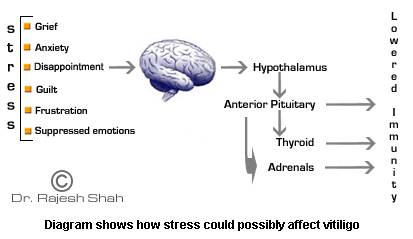
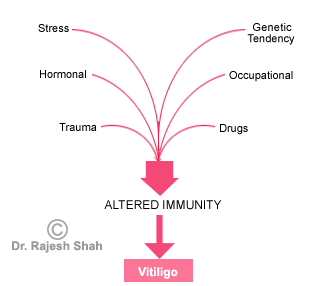

Vitiligo and Hypothyroidism (Underactive thyroid)
Research suggests that Vitiligo and Hypothyroidism (Underactive thyroid) often predisposed to the same gene (NALP1 gene). All patients with Vitiligo are suggested to get the Thyroid profile done every six months. A thyroid profile entails a blood sample study for T3, T4, and TSH (thyroid-stimulating hormone) hormones at a small cost.
Vitiligo after injury: In some cases of vitiligo, patients are at risk of losing pigment or developing vitiligo after any bruise or injury. One such example can be seen in a case photo on this page.
Other factors: The precipitating factors have been identified as due to the pressure of tight clothes (such as on the waist) or certain occupational hazards, such as wearing certain rubber hand gloves. Long-term intake of certain drugs is found to produce this pigment disorder. In many cases, especially in children, we often have no clue why one develops vitiligo.
All said and done, there is definitely an abnormal process of melanocyte destruction and defective melanocyte formation, governed by known or unknown factors.
It may be noted that some of the above remarks are based on our study of over 6500 cases and they may not be found in the standard dermatological textbooks. We are still learning and exploring vitiligo, like many other diseases.
Like many disease conditions, the exact cause yet remains a mystery!
Lichen Planus, Psoriasis, and vitiligo
Some cases of Lichen Planus and Psoriasis may be observed to be associated with vitiligo in the same location. In some cases, Psoriasis or Lichen Planus may be a cause of loss of pigment, leading to vitiligo, which is relatively more difficult to treat, as per our experience at Life Force. Here you can see a couple of illustrative cases of the concomitant existence of these disease conditions.
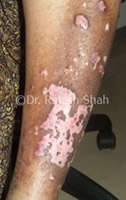
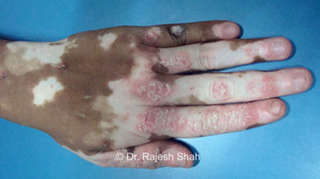
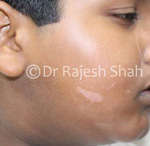
Vitiligo associated with Diabetes, Underactive Thyroid, Alopecia areata
All of the above-stated diseases are auto-immune diseases. In our clinical practice, we have observed that if Vitiligo is associated with one or more of the above diseases, it is more difficult to treat due to the higher immunological burden in the patient. The treatment approach also changes in the case of Vitiligo + Underactive Thyroid or Vitiligo + Alopecia areata, and likewise.
Written & Approved by-
Dr. Rajesh Shah
M.D. (Hom.)